As the campaign for the 2020 USA Presidential elections is in full swing, newspapers and analysts have been writing about & analysing the donations made to candidates. All this is possible because of the availability of timely & easily accessible information about political contributions. India has much to learn & emulate from the US as far as transparency in political funding is concerned.
Political financing is an important aspect of democracy. Political parties and individuals running for office incur expenditure in the form of campaign expenditure, PR & advertising, salaries of the staff, maintenance of offices etc. Financial resources to meet this expenditure are sought from various sources.
This could include public financing, where the elections are funded through public resources like taxes and governed by public or a designated body. Political financing can also be through self-financing where the candidate uses his/her personal resources, or they can opt for private financing where they seek support through political donations from public (individuals & organizations) who have vested or common interest.
Since the primary purpose of most of the political parties and their involvement in elections is to seek positions of power, there is a possibility that the funding from various sources could be in anticipation of favours in return and that the support is not necessarily ideological, or issue based.
Such favour seeking can have a detrimental effect on the tenets of good governance & democracy itself. Hence, democracies across the world are engaged in efforts of bringing in transparency in political financing. Transparency in political funding is an important tenet of a mature democracy and could expose such favour seeking after the elections. However, the level of transparency and the laws relating to such funding vary in different countries.
United States of America (USA) is the oldest modern democracy in the world and has over time evolved processes which are more standardised & systemic compared to other countries. In the context of the on-going US Presidential elections campaign, we explore the statutes governing campaign finance in USA and their implementation.
Federal Election Commission enforces Campaign Finance laws at Federal level
Since the early 19th Century, there have been efforts to brining in campaign finance reforms in USA. President Theodore Roosevelt had in 1905, highlighted the need for campaign finance reform and legislation that would ban corporate contributions for political purpose. During the period 1907-1966, the US congress enacted several statues for this purpose.
In 1971, the US Congress consolidated all these reforms and enacted Federal Election Campaign Act (FECA), which brought on in more stringent disclosure requirements for federal candidates, political parties & Political action committees (PACs).

In light of reports regarding serious financial abuse in the 1972 presidential campaign, FECA was amended in 1974 with limits now being set on contributions by individuals, political parties and PACs. To enforce these laws, the Federal Election Commission (FEC) was established as an independent agency. FEC has jurisdiction over the financing of campaigns for U.S House, the U.S. Senate, the Presidency and the Vice Presidency.
In 1979, major amendments were made to streamline the disclosure process and expand the role of political parties. This was following a constitutional challenge in the Supreme Court in the case of Buckley vs Valeo.

The next set of major amendments regarding campaign finance were made through Bipartisan Campaign Reform Act of 2002 (BCRA). This act banned national political party committees from raising or spending non-federal funds also called as ‘Soft Money’. The act also prohibited state and local party committees from using soft money for activities that affect federal elections. The BCRA also restricted issue ads and increased contribution limits.
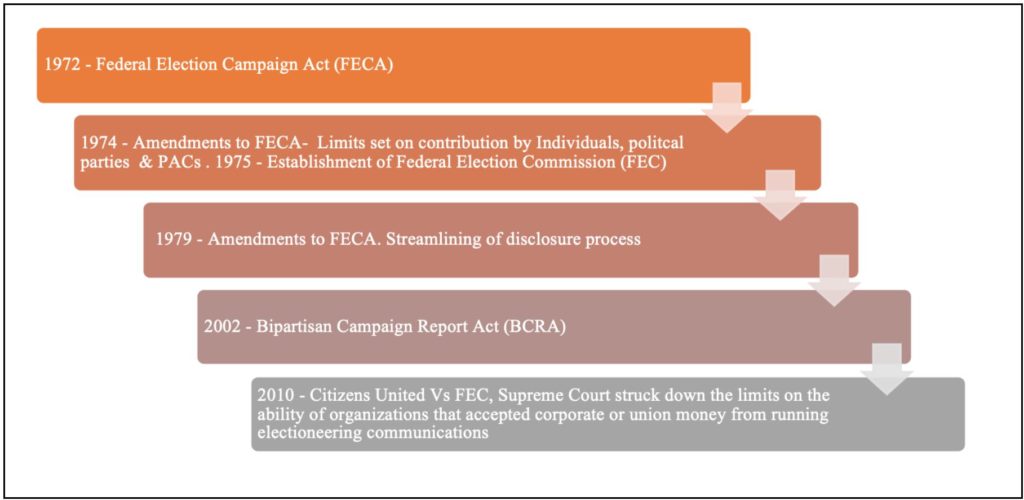
FEC allows contributions from Individuals and Political Action Committees among others
The FEC determines the eligibility of those who can contribute to the Federal candidates and also prohibits few from contributing. The contributions are subject to the limits specified by FEC for each type of contributor.
Here is the list of who can contribute and who are prohibited from contributing as per the FEC rules.
The FEC further highlights the different types of contributions that can be made as campaign support. These include :
- Direct monetary contributions and loans
- In-kind contributions
- Earmarked contributions
- Lobbyist bundled contributions
- Joint contributions
- Joint fundraising
- Transfers
- Proceeds from sales
As per FECA, all the contributions are subject to limits. Except for the contributions that are made from a candidate’s personal funds, the limits are applied for all the contributions. The FEC has provided in detail the limits for each of the contributions as well as how the limits work for each of campaigns, like – caucuses & primaries, contribution to Presidential & Vice Presidential candidates, contributions to general elections etc.
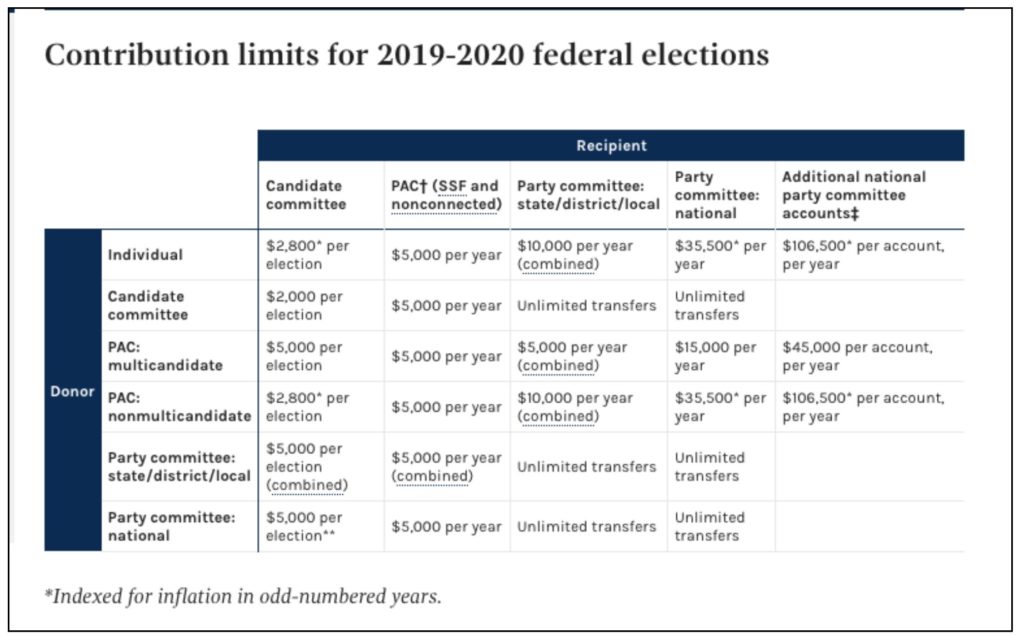
Apart from these limits , there are other limits specified by FEC :
- $100 limit on cash contributions from a particular source
- $50 limit on anonymous contributions
FEC recommends the contributors to clearly designate the contribution to a specific election, as this helps in determining the contribution limits. Furthermore, it also recommends to clearly specify the date of contribution made by the contributor and the date the contribution as received by the campaign.
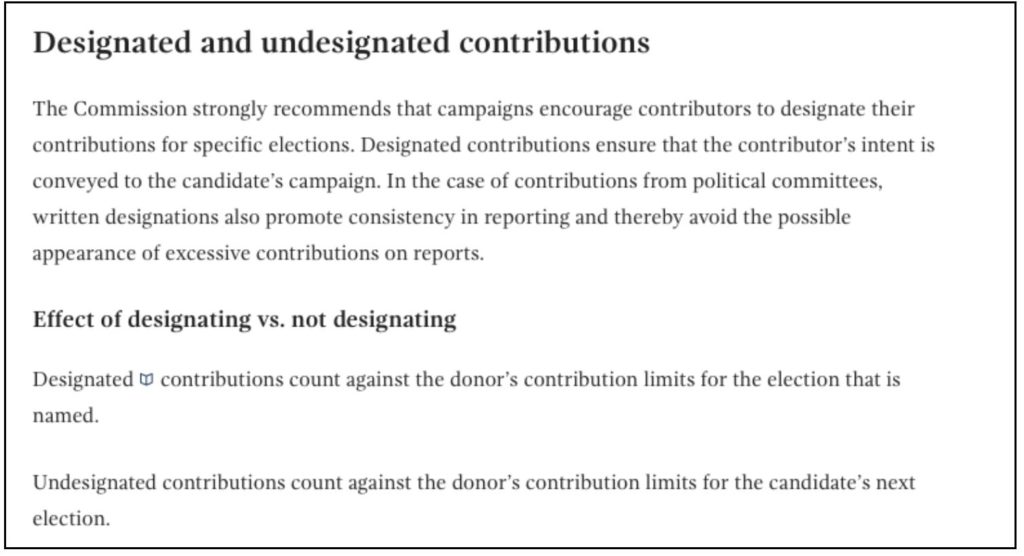
Clear guidelines laid down for reporting and disclosure of the contribution received
The FEC provides clear guidelines on how the campaigns should report different types of contributions received by them. The information includes, the forms to be used for reporting, specifications on what to be reported, how to submit the report of contribution received etc.
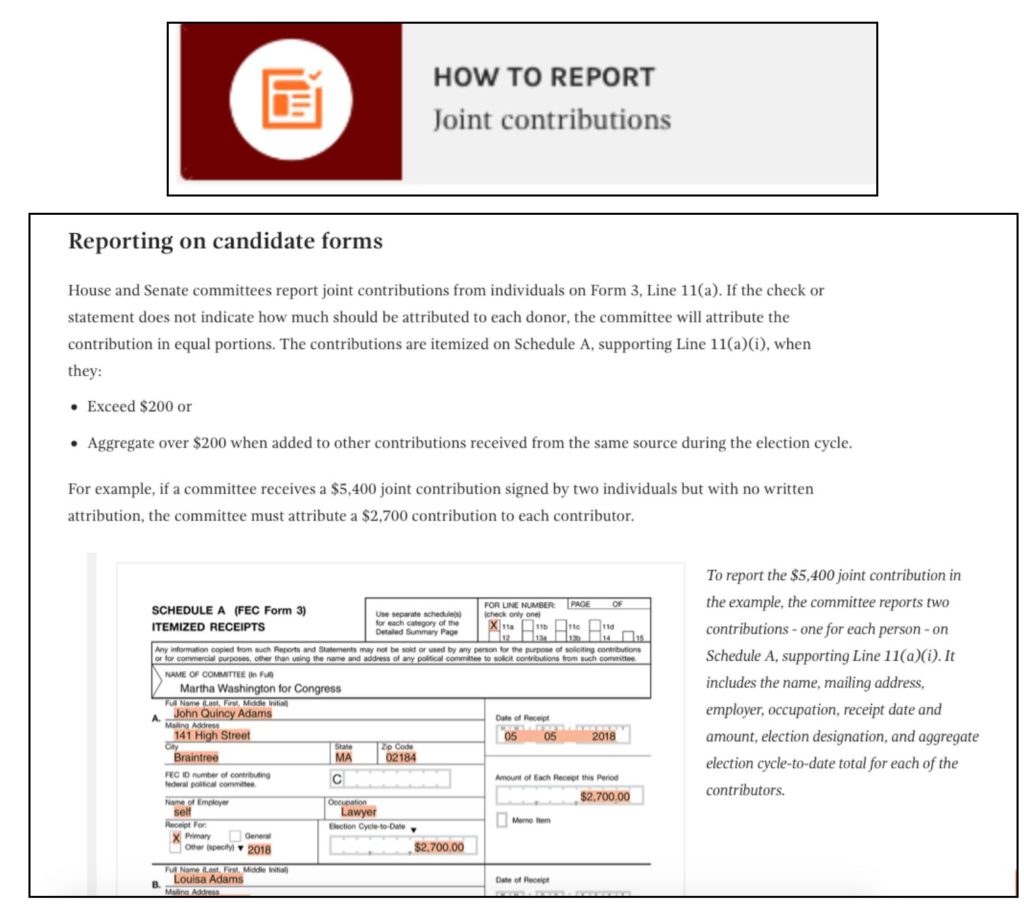
FECA requires candidate committees, party committees, PACs etc i.e. all those who receive the contributions for campaigning to file periodic reports which disclose the details of the money raised and spent.
The reporting for receipt of funds follows a flow where in the candidates contesting the elections need to disclose all the PACs and Party committees that provide them the contributions. They in turn would identify and report all the individuals who have contributed to them (more than $200). All the expenditure exceeding $200 also needs to be duly reported.

FEC provides reporting dates on which the respective campaigns need to submit their reports. The filing of the reports can happen either electronically or manually by mailing paper reports.
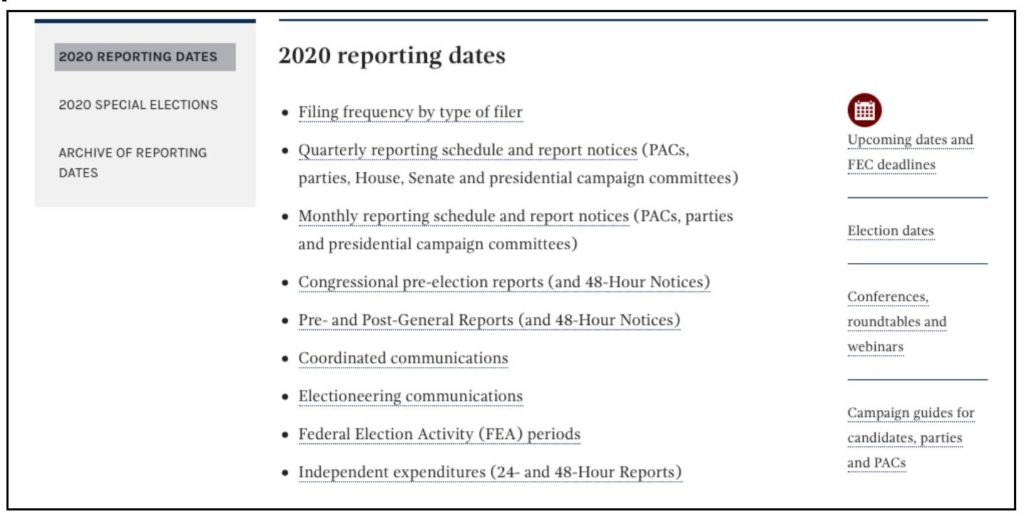
The FEC maintains the database of all this information and publishes information about the campaigns and donors on its website for public view.


On the website, the information can be pooled in respect to the total amount raised and spent by candidates, by different election & party committees etc.
For example, one can access the information and the details of all the individual contributors.
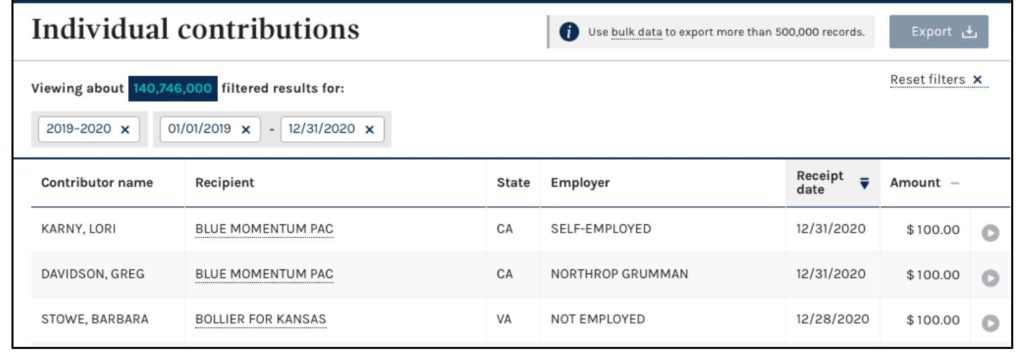
Or the information can be sought by the amount received and disbursed by the candidates.
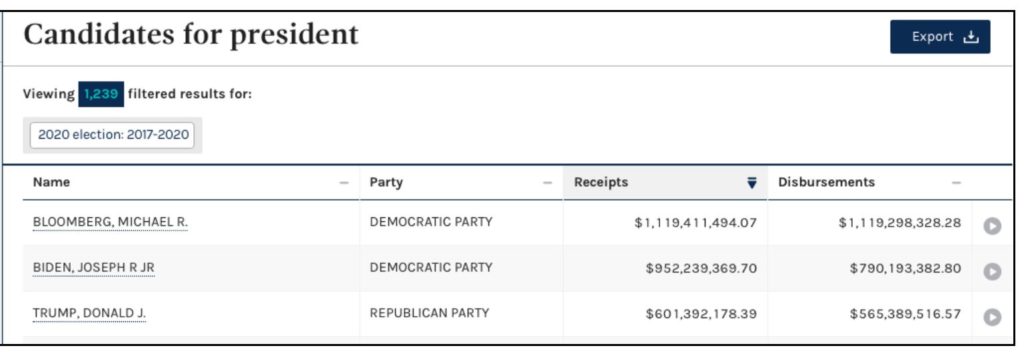
Loopholes in US Campaign Finance laws are taken advantage by the candidates
The FEC has been effective in setting up checks & balances in place for transparency in campaign finance. However, time and again candidates have found workarounds to solicit more campaign funds and not disclose them. The amendments in the campaign finance laws are a testimony to the continuous work in progress to identify these loopholes and rectify them.
A report published by Bipartisan policy centre, titled ‘Campaign Finance in the United States; Assessing an Era of Fundamental Change’ highlights few of the recent challenges regarding transparency in US election campaign financing.
- Super PAC facilitating influence of select few on campaign finances
- Undisclosed money coming into the system through 501 (c) (4) organizations i.e. social welfare organizations and to an extent through Super PACs.
Despite these loopholes, there is enough transparency in the campaign finance laws coupled with timely & easily accessible disclosure of contributions. This is an area that the Indian political funding laws are yet to catch up with.
Indian Political funding laws lack transparency and do not provide for timely public access to information
As highlighted, the campaign finance laws in USA require regular and timely submission & disclosure of contribution reports from candidates & parties. The information is in the form of periodical reports like quarterly updates or real-time reports by election campaigns. The FEC publishes all of this information on the public and provides near up to date information of the trends in campaign financing. Furthermore, the disclosures contain granular information – by individual contributor, by candidate, by PAC, by election campaign etc there by providing transparent and holistic information in the public domain. Any citizen can easily access this information.
However, the same cannot be said regarding political funding laws in India. The Election commission of India (ECI) has over the years driven various initiatives to bring in some kind of transparency in the way political parties receive political funding but there is much left to be desired on this front.
Currently, the yearly Audit, Contribution & Expenditure reports submitted by the political parties are the only data available in public domain to understand political funding and expenditure. However, as experience shows, these reports are rarely submitted on time. Factly has early written multiple stories on this. Even for the previous financial year (2019-20), although the usual cut-off date is 31 October, only two state parties have submitted their contribution reports and none of the National parties have. Not a single party has submitted their annual audit report for 2019-20. Bulk of the funding for the 2019 Lok Sabha general elections would have been received by the political parties in April & May of 2019. But even after 18 months, the citizens have no idea of who contributed and how much to political parties.
Even timely submission of reports does not provide a holistic understanding of the contributions received by the political parties, as the information is provided well after an election. This challenge in ascertaining the extent of funding received through opaque electoral bonds & their contributors was highlighted by us in an earlier story. There are transparency challenges even with the threshold limits for anonymous donations through other means.
It is high time that the Parliament amend the existing laws so as to bring in greater transparency in political funding and do away with anonymous funding except for smaller amounts of less than Rs. 1000 or so. On the other hand, the ECI could think of creating a platform where timelier & easily accessible information regarding the political contributions & expenditure is made available for the public, instead of just uploading scanned reports submitted by political parties.
Featured Image: Transparency in Political Funding



1 Comment
Pingback: Transparency in Political Funding: India has much to learn from the USA - Factly - Copied News